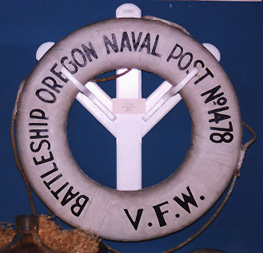 As the Washington
Naval Treaty was being put into effect, it was realized that the
United States needed to trim its list of battleships in order
maintain compliance with the treaty. Naturally, only the most
modern battleships could be on the active rolls of the Navy, so
the USS Oregon, officially designated BB-3 in 1920, was
stricken from the list of US battleships and prepared for scrapping.
The citizens of the nation protested, particularly those in the
State of Oregon. The Oregon citizens, supported by the state government,
petitioned the Federal government that the battleship be given
to the State of Oregon with the purpose of establishing a memorial.
The Federal government finally agreed with the provisions that
the USS Oregon would remain property of the Federal government,
that adequate funds would be generated and be used for upkeep
of the ship, and that the ship was maintained in a safe condition
for visitors. The state agreed to the provision.
As the Washington
Naval Treaty was being put into effect, it was realized that the
United States needed to trim its list of battleships in order
maintain compliance with the treaty. Naturally, only the most
modern battleships could be on the active rolls of the Navy, so
the USS Oregon, officially designated BB-3 in 1920, was
stricken from the list of US battleships and prepared for scrapping.
The citizens of the nation protested, particularly those in the
State of Oregon. The Oregon citizens, supported by the state government,
petitioned the Federal government that the battleship be given
to the State of Oregon with the purpose of establishing a memorial.
The Federal government finally agreed with the provisions that
the USS Oregon would remain property of the Federal government,
that adequate funds would be generated and be used for upkeep
of the ship, and that the ship was maintained in a safe condition
for visitors. The state agreed to the provision.
Above: USS Oregon arriving in Portland, Oregon, circa 1921?
Courtesy: Eugene Naval and Marine Corps Reserve Center, Eugene, Oregon
The ship, currently in Bremerton, was rendered unserviceable. Her engines were dismantled, the propeller shafts were cut, and her great guns plugged. She was then towed out of Puget Sound, down the Washington coast to the mouth of the Columbia River. Just before entering the city of Portland, on the Willamette River, the 1925 Rose Festival queen and her court boarded the ship for commemoration of the Oregon's mooring in the City of Roses. The arrival of aged warrior signal the commencement of the city's annual celebration, the Rose Festival. The USS Oregon was officially accepted from the US Navy on July 3, 1925, the anniversary of the Battle of Santiago.
After the Rose Festival ended, the Battleship Oregon Commission was formed to administer the battleship. The first five person commission included the following: Col. Carle Abrams, a Spanish-American War and World War I veteran; Mr. Howard Waddell, a Spanish-American War and World War I veteran; Mr. Lafe Manning, a Spanish-American War Veteran and former Oregon crewmember; Col. U.G. Worrell (retired), a Spanish-American War and World War I veteran; and Mrs. Cora Thompson, wife of a Spanish-American War veteran. In 1928, Mrs. Thompson resigned from the committee to assume duties as the Secretary and Business Manager. Plans were soon made for the Oregon to be a floating museum in order to honor the nations veterans and maintain its naval heritage. Soon military artifacts streamed in from all over the United States, later Canada, and as far away as England. The loaned artifacts were put on display for the Oregon's many visitors to enjoy.
 The Oregon
was living a grand life of retirement. Boys Scouts, Sea Cadets,
and other civic organizations held meetings on board her. Thousands
of school children and adults alike walked the decks of the Oregon
and experienced a part of naval history for the admission price
of twenty five cents.
The Oregon
was living a grand life of retirement. Boys Scouts, Sea Cadets,
and other civic organizations held meetings on board her. Thousands
of school children and adults alike walked the decks of the Oregon
and experienced a part of naval history for the admission price
of twenty five cents.
The Commission, in 1938, proposed a project that would enclose the Oregon in concrete and provide a focal point for the waterfront of Portland. But, as with the rest of the country, the State of Oregon was in the midst of the Great Depression and funds for the completion of this worthwhile project were not available. The ship was moved to a more secure basin, but the concrete enclosure that would have saved the ship never materialized. Time was running out for the fabled old warrior.
Photo above: A life ring similar to that used on the Oregon now located at the Oregon Maritime Center and Museum. While the USS Oregon was berthed at Portland, numerous civic organizations utilized the old battleship. One such group was Veterans of Foreign Wars Post No. 1478. They played an instrumental role in preserving the ship. Photograph taken by website author.